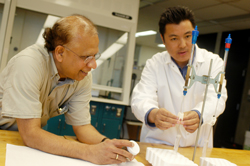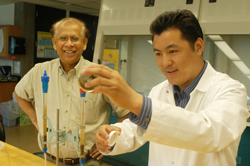"Green" Chemistry
 As an analytical chemist, Dula Amarasiriwardena has spent decades honing his skills in trace-metal detection. As a chemistry professor at Hampshire, he thrives on sharing that knowledge with his students.
As an analytical chemist, Dula Amarasiriwardena has spent decades honing his skills in trace-metal detection. As a chemistry professor at Hampshire, he thrives on sharing that knowledge with his students.
One of his recent collaborations was with Pema Dorjee 06F, who arrived at Hampshire planning to study the social sciences.
After taking Amarasiriwardena's course on Pollution and the Environment, Dorjee's focus quickly led him into the chemistry laboratories at the Cole Science Center instead.
"Pema hadn't studied the physical sciences at all before coming here," says the professor.
Dorjee came to Hampshire through an exchange program with his prior school, the Central Institute of Higher Tibetan Studies in Sarnath, India. With Amarasiriwardena's assistance, Dorjee was able to bridge his newfound interest in chemistry (which was cemented after a summer internship) with additional studies in the social sciences.
"Working with Dula is so much fun," says Dorjee. "He knows so much and guides you through step by step. And he's trying to use knowledge to do good things for communities."
In Dorjee's final year at Hampshire, the two researched an innovative way to remove harmful metals from soil. Work like this is one of the reasons the Hampshire Fund exists, as it provides financial assistance for research and technologies while allowing students and professors to collaborate together both in the lab and the field.
"Pema worked with me on nanoparticles, which is anything less than one billionth of a meter. At that dimension, some of the chemical and physical properties change," says Amarasiriwardena. "We synthesize these materials, and we are interested in their capabilities for environmental remediation, and in this case to absorb metals." The nanoparticle Dorjee and Amarasiriwardena focused on specifically is nanosized zero-valent iron, or nZVI for short.
The nanoparticle Dorjee and Amarasiriwardena focused on specifically is nanosized zero-valent iron, or nZVI for short.
It's proven to be effective in soaking up antimony, a toxic metalloid similar to arsenic that's used in things like pesticides, and to absorb heat in everything from bullets to brake pads.
But there remain challenges that the student and professor worked together to overcome.
"You can put nZVI in a contaminated site and if you have 100 grams of antimony, it will absorb half of it within a minute," says Amarasiriwardena. "But if you put nZVI in the ?real world' soils that are rich in organic matter, the effectiveness of antimony absorption by nZVI will slow down. But this remediation approach with nZVI still works but soaking up of antimony is a bit slow!"
Trying to find a way to keep the absorption rate high was something that appealed to Dorjee. At the Central Institute his studies were mostly in Buddhism, which helped to develop a socially conscious philosophy. In the nZVI research, he saw a way in which he could positively impact people's lives and the environment through "green" chemistry. It's a focus that Amarasiriwardena has built his career around, and seeing Dorjee heading down a similar path is a satisfying conclusion to their years of collaboration.

